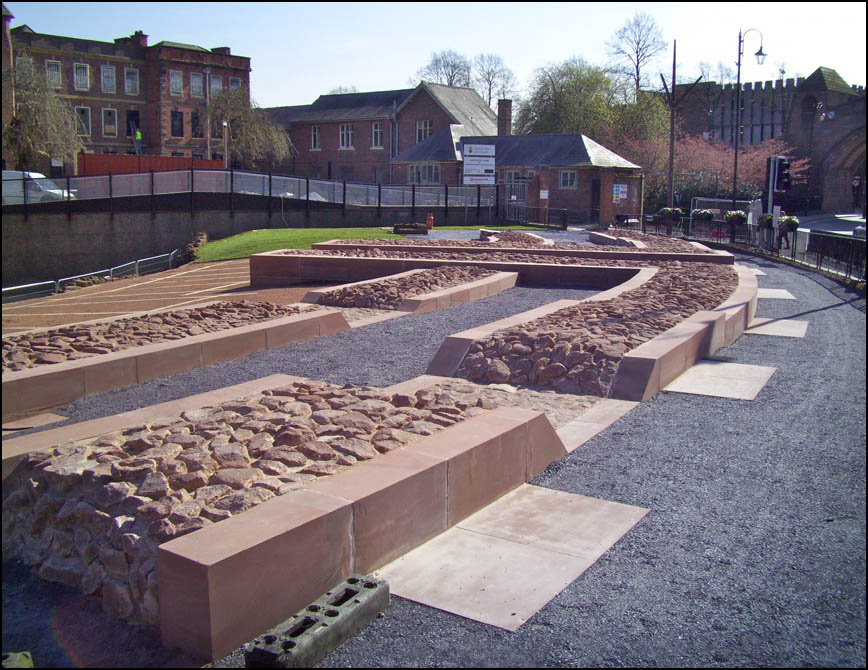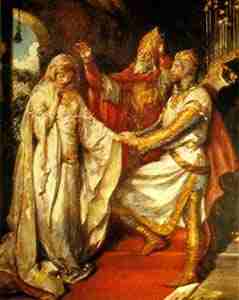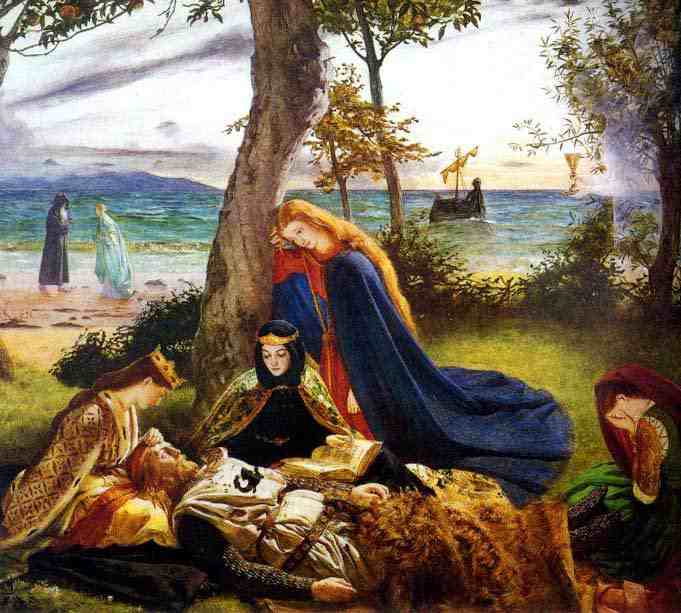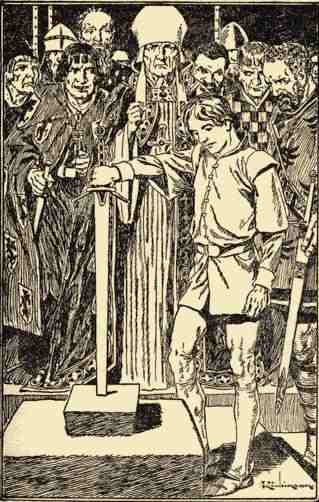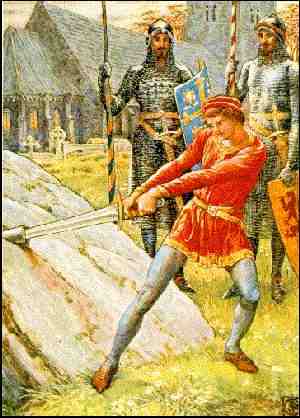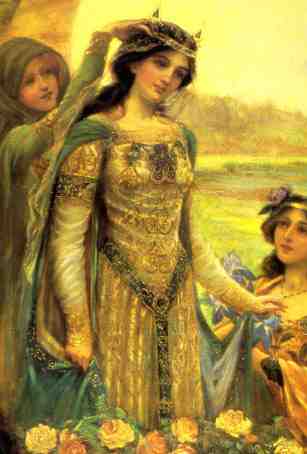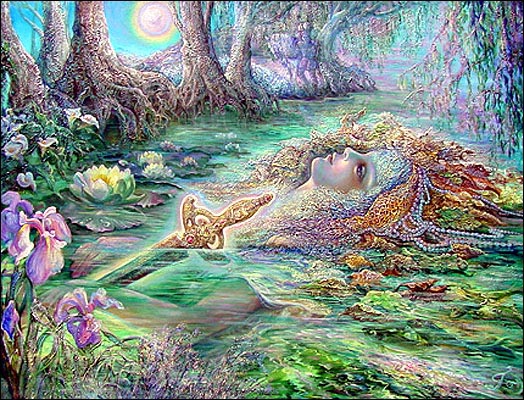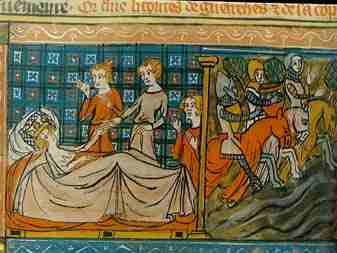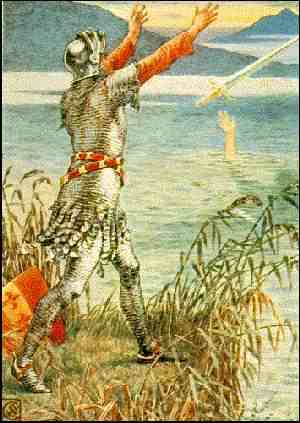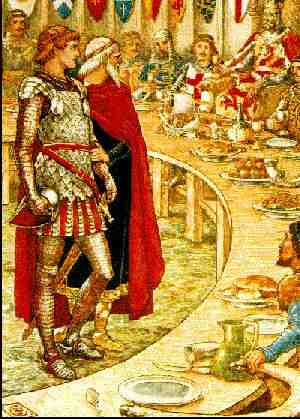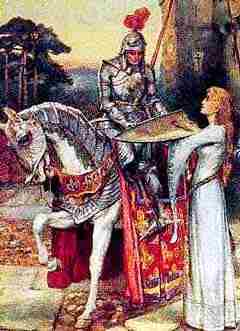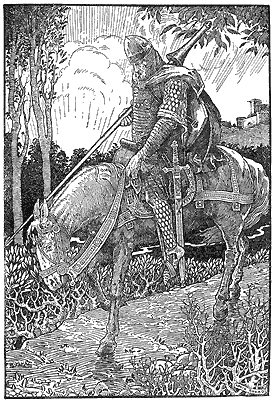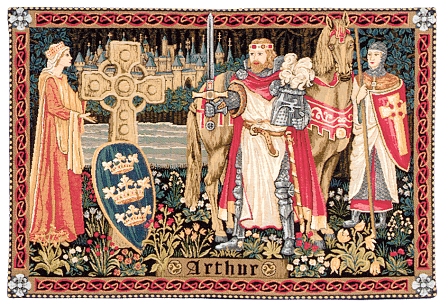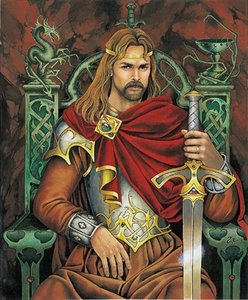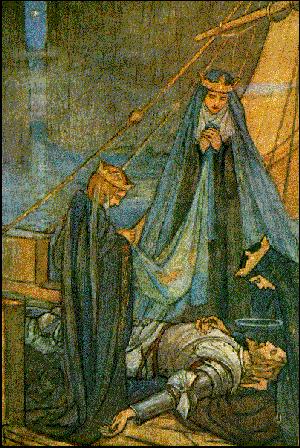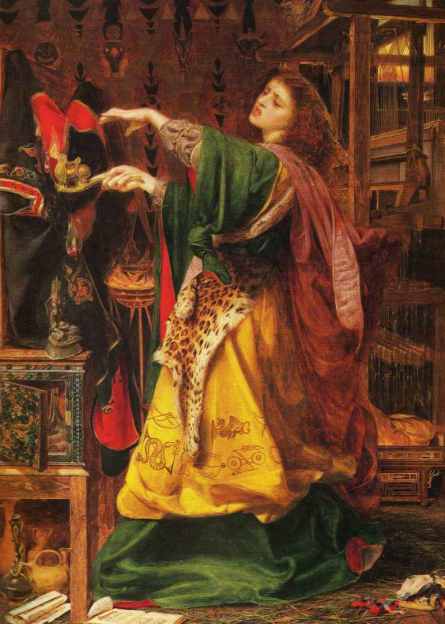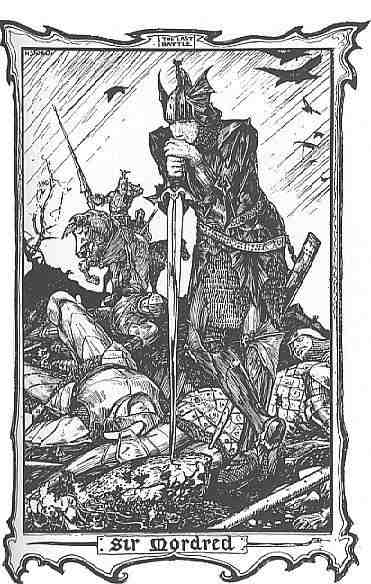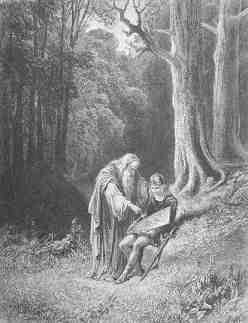AVALON
The Theosophy
King Arthur Pages
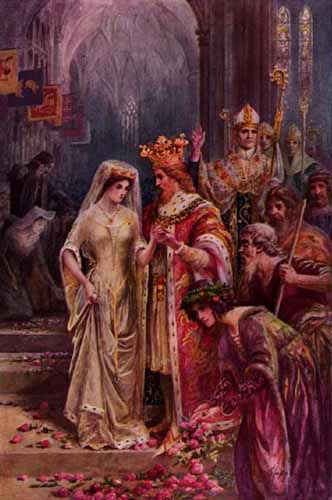
King Arthur’s
Marriage to Guinevere
Merlin
His
origins and development
over
centuries
From wise child with no earthly father to
Megastar of Arthurian Legend
Merlin the magician is one
of the most colourful characters in the Arthurian Legend. Merlin is the creation
of Geoffrey of
Monmouth, who in his History of the Kings of
The modern traditional story of
Merlin is that he was the illegitimate son of a monastic Royal Princess of
Dyfed. The lady's father, however, King Meurig ap Maredydd ap Rhain, is not
found in the traditional Royal Lineages of this kingdom and was probably a
chieftain of the region bordering on Ceredigion. Merlin's father, it is said,
was an angel who had visited the Royal nun and left her with child. Merlin's
enemies claimed his father was really an
incubus, an evil spirit that has intercourse with sleeping women.
Accounts of the 4th
century then tells us that after the Roman withdrawal from Britain and
Vortigen’s usurpation of the throne from the rightful heirs that the Saxons
were occupying large areas of the country. Vortigern was in flight from the Saxon breakout and went to
Snowdonia, in North Wales, in hopes of constructing a mountain fortress at Dinas Emrys
where he might be safe. Unfortunately, the building kept collapsing and
Vortigern's house wizards told him that a human sacrifice of a fatherless child
would solve the problem. One small difficulty was that such children are rather
hard to find. Fortunately for Vortigern's fortress, Merlin was known to have no
human father and happened to be available.
Before the sacrifice
could take place, Merlin used his great visionary powers and attributed the
structural problem to a subterranean pool in which lived a red and a white
dragon. The meaning of this, according to Merlin, was that the red dragon
represented the Britons, and the white dragon, the Saxons. The dragons fought,
with the white dragon having the best of it, at first, but then the red dragon
drove the white one back.
The meaning was
clear. Merlin prophesied that Vortigern would be slain and followed on the
throne by Ambrosius Aurelianus,
then Uther, then a greater leader, Arthur. It would fall to him to push the
Saxons back.
True to the prophecy, Vortigern was slain
and Ambrosius took the throne. Later, Merlin appears to have inherited his
grandfather's little kingdom, but abandoned his lands in favour of the more
mysterious life for which he has become so well known.
After 460 it is alleged that British nobles
were massacred at a peace conference, as a result of Saxon trickery, Ambrosius
consulted Merlin about erecting a suitable memorial to them. Merlin, along with
Uther, led an expedition to Ireland to procure the stones of the Chorea
Gigantum, the Giant's Ring.
Merlin, by the use of his extraordinary
powers, brought the stones back to a site, just west of Amesbury, and
re-erected them around the mass grave of the British nobles. We now call this
place
After his death, Ambrosius was succeeded by
his brother, Uther, who, during his pursuit of Gorlois and his irresistable wife, Ygerna (Igraine or Eigr in some texts), back to their lands in
After Arthur's
birth, Merlin became the young boy's tutor, while he grew up with his
foster-father, Sir Ector (alias Cynyr Ceinfarfog the Fair Bearded). In
the defining moment of Arthur's career, Merlin arranged for the
sword-in-the-stone contest by which the lad became king. Later, the magician
met the mystic Lady of the Lake
at the Fountain of Barenton (in Brittany) and persuaded her to present the King
with the magical sword, Excalibur. In the romances, Merlin is the creator of
the Round Table, and is closely involved in aiding and directing the events of
the king and kingdom of Camelot.
He is pictured by
Geoffrey of Monmouth, at the end of Arthur's life, accompanying the wounded
Arthur to the Isle of Avalon for the healing of his wounds. Others tell how
having fallen deeply in love with the Lady of the Lake, he agreed to teach her
all his mystical powers. She became so powerful that her magical skills
outshone even Merlin's. Determined not to be enslaved by him, she imprisoned
the old man in a glass tower, a cave or similarly suitable prison. Thus his
absence from the Battle of Camlann was ultimately responsible for Arthur's
demise.
Merlin is likely to be an amalgam of several well-known bards, of which
Myrddin was one. The earliest mention of Myrddin is in Aneirin's The Gododdin.
The other figure of this composite Merlin is probably the bard Lailoken, who is
mentioned in the 12th century, Life of St. Kentigern.
In Geoffrey's book, Merlin assists
Uther Pendragon and transports the stones of Stonehenge from Ireland, but there
is no Arthurian connection in Geoffrey's works.
Merlin became a widely used character
in the Middle Ages. Merlin is a central character in the thirteenth-century
French Vulgate cycle.
Sir Thomas Malory, in the Morte
d'Arthur presents Merlin as the adviser and guide to Arthur.
Tennyson makes Merlin the architect
of Camelot. And Merlin features in Mark Twain. Numerous novels, poems and plays
are centred around Merlin. Merlin is perhaps the most frequently portrayed
Arthurian character.
Several sites associated with
Merlin's birthplace,
Merlin’s burial place is said to be
1 Beneath Merlin's Mound at Marlborough
College in Marlborough (Wiltshire),
2 Drumelzier in Tweeddale (Scotland)
3 Bryn Myrddin (Merlin's Hill) near
Carmarthen (South Wales)
Le Tombeau de Merlin (Merlin's Tomb) near Paimpont
(Brittany)
Ynys Enlli (Bardsey Island) off the Lleyn
Peninsula (North Wales). This site is also claimed by some to be the Isle of
Avalon.
Various stories associated with
Merlin are:-
1. Vortigern died and Ambrosius
became king. Merlin was his advisor. After a bloody battle with many killed,
Ambrosius asked Merlin how the dead should be remembered; Merlin advised that
Stonehenge be built as a memorial. The stones needed were in Ireland, and it
needed an invasion of Ireland by Uther, who with help from Merlin brought the
stones back to build Stonehenge..
2. Merlin was responsible for Arthurs
conception, making Uther appear as her husband to Igraine. The result of the
union was Arthur.
3. Robert de Boron repeats Geoffrey's
story of Merlin's origin and embroiders it with the creation of the Round Table
and the Holy Grail story. He foresees the need for a Round Table and for
Arthur. He arranges the birth of Arthur as in Geoffrey. The infant Arthur is
given to Merlin for safe keeping, and the King Arthur is proclaimed when the
boy Arthur pulls the sword Excalibur from an anvil set on top of a stone.
4. Merlin helps Perceval fulfill the
Grail Quest.
5. In Malory Merlin is the magician
at the court of Camelot, fighting off the spells of Morgan Le Fay and other
witches.
6. Merlin falls under the influence
of the Lady of the Lake. The result being that she puts one of his own spells
on him, and he is locked away in a glass tower. Tennyson shows Merlin as a tired old man who almost
seems to want to be locked away.
Was Geoffrey on Monmouth’s Merlin based on a
later figure?
According to Geoffrey's Vita Merlini (The Life of Merlin) Circa 1151 CE Merlin/Myrddin was
a sixth century prophet living in the North of Britain, probably Cumbria, where
his career extended beyond Arthur. Merlin travelled north, after Camlann, to
the court of King Gwendoleu of Caer-Guenoleu (north of the Salway) where the
locals called him Lailoken (or Llallogan).
Shortly afterward, a war broke out between
Merlin's Royal master and the three allies, King Riderch Hael (the Generous) of
Strathclyde and Kings Peredyr & Gwrgi of Ebrauc (York). Gwendoleu was
killed in the ensuing Battle of Ardderyd (Arthuret) and Merlin, sent mad with
grief at the death of his nephew and four brothers, fled into the Caledonian
Forest.
He lived there in a mad frenzy for over a
year, becoming known as Myrddin Wylt (the Wild), before Riderch, who was his
brother-in-law, found him and brought him to safety in the Strathclyde Court.
Some scholars believe there were two
Merlins: Myrddin Emrys and Myrddin Wylt. The fact that Merlin apparently lived
from the reign of Vortigern (c.420) to the reign of Riderch Hael (c.580) would
certainly support this view.
The stretch from Vortigern to Arthur is
itself unlikely and early versions of the "Vortigern at Dinas Emrys"
story give the fatherless boy as Emrys Wledig (Ambrosius Aurelianus) who was
living in Campus Elleti in Glywysing. Despite Myrddin Wylt's story indicating
he may have had a conceptual origin in one of the wild-man-in-the-woods motifs
common to the ancient folklore of the British Isles, this man's historicity is
quite well established. His real name, however, may have been Lailoken.
Was this man misplaced in time, by Geoffrey
of Monmouth, to become King Arthur's mentor, some memory of a similar character
from Caer-Fyrddin giving rise to his new name? PC Bartrum thinks not and points
out that "fundamentally there is only one Merlin/Myrddin, and some of the
later legends cannot be consistently classified as appropriate to one rather
than the other."
His prison and/or burial place is said to be
beneath Merlin's Mound at Marlborough College in Marlborough (Wiltshire), at
Drumelzier in Tweeddale (Scotland), Bryn Myrddin (Merlin's Hill) near
Carmarthen (Wales), Le Tombeau de Merlin (Merlin's Tomb) near Paimpont
(Brittany) and Ynys Enlli (Bardsey Island) off the Lleyn Peninsula (Wales).
Theosophy
Avalon

King Arthur &
The Round Table
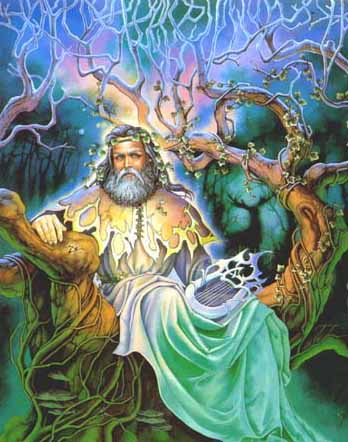
Merlin & The Tree of Life
Merlin
the Magician
Born
circa 400 CE ; Welsh: Myrddin;
Latin:
Merlinus; English: Merlin.
The restored and
landscaped Chester Amphitheatre
Some historians
believe that this was the site
of King Arthur’s
Round Table. Chester’s Roman fortifications
and its proximity to
the Welsh border have always made it a
strong candidate for the location of Camelot.
Chester is also often credited with
being the site of
“ The Battle of the
City of the Legion”
which was King Arthur’s ninth victory
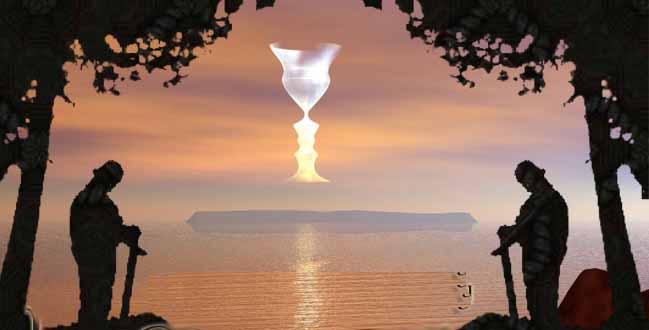
The Holy Grail
The Theosophy
King Arthur Pages
____________________
General pages
about Wales, Welsh History
and The History
of Theosophy in Wales
Theosophy
links
The Most Basic Theosophy
Website in the Universe
A quick overview of Theosophy
and the Theosophical Society
If you run a Theosophy Group you
can use this as an introductory handout.
Independent Theosophical Blog
One liners and quick explanations
About aspects of Theosophy
H P Blavatsky is usually the only
Theosophist that most people have ever
heard of. Let’s put that right
The Voice of the Silence Website
An Independent Theosophical Republic
Links to Free Online Theosophy
Study Resources; Courses, Writings,
The
By
William Quan Judge
GENERAL PRINCIPLES THE EARTH CHAIN
BODY AND ASTRAL BODY KAMA – DESIRE
KARMA KAMA LOKA
DEVACHAN
CYCLES
Classic Introductory Theosophy Text
A Text Book of Theosophy
By C
What Theosophy Is From the Absolute to Man
The Formation of a Solar System The Evolution of Life
The Constitution of Man After Death
Reincarnation
The Purpose of Life The Planetary Chains
The Result of Theosophical Study
Reincarnation
This
guide has been included in response
to the
number of enquiries we receive on this
subject
at Cardiff
Theosophical Society
From A Textbook
of Theosophy By C W Leadbeater
How We Remember our Past Lives
Life after Death & Reincarnation
The
Slaughter of the
a
great demand by the public for lectures on Reincarnation
An Outline of Theosophy
Charles Webster Leadbeater
Theosophy - What it is How is it Known?
The Method of Observation General Principles
Advantage Gained from this
Knowledge
The Deity The Divine Scheme The Constitution of Man
The True Man Reincarnation The Wider Outlook
Death Man’s Past and Future Cause and Effect
No
Aardvarks were harmed in the
The Occult World
By
Alfred Percy
Sinnett
The Occult
World is an treatise on the
Occult and
Occult Phenomena, presented
in readable style, by an early giant of
the
Theosophical Movement.
Preface to the American Edition Introduction
Occultism and its Adepts The Theosophical Society
First Occult Experiences Teachings of Occult Philosophy
Later Occult Phenomena Appendix
Theosophy Birmingham (England)
The Birmingham Annie Besant Lodge
The Seven
Principles of Man
By
Annie Besant
The Voice of the Silence Website
The Spiritual Home of Urban Theosophy
The Earth Base for Evolutionary Theosophy
Theosophical Glossary
Published 1892
A B C D EFG H IJ KL M N OP QR S T UV WXYZ
Try these if you are looking for a
local Theosophy
Group or Centre
UK Listing of Theosophical Groups
Theosophy House
Arthurian Picture Gallery
Arthur Marries Guinevere
Death of Arthur
Arthur draws the Sword from the Stone
Arthur draws the Sword for the Stone
Guinevere
The Lady of the
Guinevere lends her ring to Sir Lancelot
The Round Table
Theosophy House
Sir Bedivere returns Excalibur to the Lake
Sir Galahad brought before the Round Table
Lancelot and Guinevere
Sir Mordred
King Arthur
King Arthur
Death of Arthur
Morgan Le Fay
Theosophy House
Merlin instructs the young Arthur
Merlin instructs the young Arthur
Theosophy House
